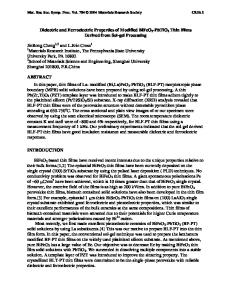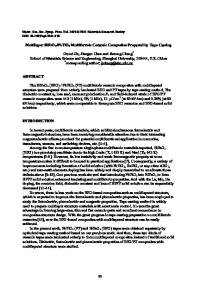Sol-Gel Synthesis and Characterization of BiFeO 3 -PbTiO 3 Thin Films
- PDF / 515,462 Bytes
- 5 Pages / 612 x 792 pts (letter) Page_size
- 98 Downloads / 473 Views
0997-I08-08
Sol-Gel Synthesis and Characterization of BiFeO3-PbTiO3 Thin Films ASHISH GARG1, SOUMYA KAR1, ANJU DIXIT2, and D C AGRAWAL2 1 Department of Materials and Metallurgical Engineering, Indian Institute of Technology Kanpur, Kanpur, 208016, India 2 Materials Science Programme, Indian Institute of Technology Kanpur, Kanpur, 208016, India ABSTRACT In this work, we report on the synthesis and characterization of thin films of (BiFeO3)1-x-(PbTiO3)x (BFPT) solid solutions of compositions around morphotropic phase boundary (MPB) grown on platinized silicon (111) Pt/TiO2/SiO2/Si substrate by sol-gel based spin coating technique. The films were post-annealed at 700 and 750∞C for 1 h in air. Morphological analysis of the films was carried out by scanning electron microscopy. Grazing incidence X-ray diffraction revealed the perovskite structure of the films and peaks suggested the presence of rhombohedral structured pure BFPT phase in polycrystalline form. Scanning electron microscopy suggested that films annealed at 750°C had a denser microstructure as compared to those at 700°C. The room temperature dielectric constant (εr′) of the films with composition of BF:PT :: 75:25 was measured to be ~1200 at a frequency of 100 kHz. INTRODUCTION Materials exhibiting two or more "ferroic" properties (such as ferroelectricity, ferromagnetism or antiferromagnetism) in the same phase are known as multiferroics. Bismuth ferrite based multiferroic materials are of great interest due to their simple perovskite structure and simultaneous co-existence of ferroelectricity and antiferromagnetism [1]. The material also has a very high ferroelectric Curie temperature (Tc ~ 830°C) which makes it attractive for high temperature sensors. However, one of the major problems in BiFeO3 has been its low electrical resistivity which has prevented any practical application of this material either as piezoelectric or magnetoelectric functional components [2]. To counter these problems, other perovskites such as PbTiO3 have been incorporated into solid solution with BiFeO3 in order to enhance the electrical insulation resistance. The pioneering work of Fedulov et al. [3] has demonstrated that bismuth ferrite-lead titanate (BFPT or (BiFeO3)1-x-(PbTiO3)x) solid solutions could be viable candidates for high-temperature piezoelectric applications, especially compositions near the morphotropic phase boundary (MPB) composition of BF:PT :: 70:30. BFPT has been shown to be promising for at least two reasons: first, depending on the concentration of PbTiO3 i.e. x, it can have a Curie temperature ranging from approximately 500°C to 800°C, higher than that of PZT based materials, and second, a very high c/a ratio (~1.17), which is an indication of a large achievable remanent polarization [4]. The purpose of this investigation is to investigate the compositional dependence on the structure and properties of (BiFeO3)1-x-(PbTiO3)x (BFPT) thin films having compositions near the morphotropic phase boundary (MPB) of this solid solution. In the present work, we presen
Data Loading...











